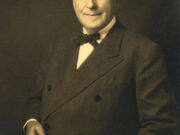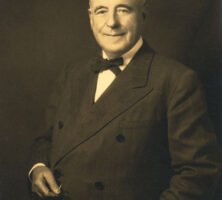Sanford Stadium, the home of the Georgia Bulldogs football team on the campus of the University of Georgia (UGA), is the twenty-first century’s most visible and tangible link to one of the state’s greatest twentieth-century educators. The stadium that bears his name was the brainchild and a favorite project of Steadman Sanford, English professor, founder of the university’s journalism school, dean, university president, and third chancellor of the University System of Georgia.
Steadman Vincent Sanford was born on August 24, 1871, in Covington to Elizabeth Steadman and Charles Vincent Sanford. In 1895 he married Grace McClatchey, with whom he had four children: Shelton Palmer, Grace Devereaux, Charles Steadman, and Homer Reynolds.
Sanford received his undergraduate degree from Mercer University in Macon in 1890, and went on to pursue graduate studies at the University of Chicago, the University of Berlin in Germany, and Oxford University in England. He received honorary degrees from UGA (Litt.D., 1914) and Mercer (LL.D., 1932). He spent his early career teaching at Marietta (1890-92) and in educational administration, as principal of Marietta High School (1892-97) and superintendent of the Marietta schools (1897-1903) before taking a position teaching English at UGA in 1903.
Sanford’s path from English professor to leadership of the state’s system of higher education was marked by his remarkably broad interests and impressive personal charm.
Among the academic and administrative highlights of his thirty-two-year career at UGA were his founding and leadership of the Henry Grady School of Journalism (later, the Grady College of Journalism and Mass Communication) (1921-27), his deanship (1927-32), and presidency of the university (1932-35). Sanford’s role in journalism education led to the establishment of the George Foster Peabody Award for excellence in broadcasting, one of the university’s most widely recognized distinctions.
During those same years Sanford was the mainstay of the university’s Athletic Association as faculty chairman of athletics. In that role he worked to improve programs and facilities and to free collegiate sports of the unsavory aspects so common in the early twentieth century. He was also the founding president of the Southern Conference (1921). It was Sanford who moved university competition from Herty Field to an improved location in the valley between the North and South campuses, a combination baseball and football venue that, over Sanford’s objections, was named Sanford Field.
Early in the 1920s Sanford and important Bulldog boosters in Atlanta and around the site began to plan for the building of a modern football stadium. Sanford recognized the importance of a suitable setting for drawing a substantial playing schedule against teams who would attract crowds and wide press coverage, advancing public and legislative support of higher education. In October 1929 Georgia defeated the Yale University team fifteen to nothing in the inaugural game at Sanford Stadium, a beautiful setting in a natural area engineered to handle a crowd of more than 30,000.
During his presidency Sanford oversaw the consolidation of what had been several semi-independent units into a unified university within a newly established university system. When he was promoted in 1935 to chancellor of the system, Sanford enlarged his aggressive promotion of education to include all the units of the system. Sanford was highly successful in securing New Deal support for building programs across the system. As a longtime Democrat, he was an enthusiastic and optimistic supporter of U.S. president Franklin D. Roosevelt.
Politics at the state level proved a touchy matter for Sanford under the governorship of Eugene Talmadge. As chancellor, Sanford’s greatest challenge was the infamous Cocking affair, during which the governor maneuvered the dismissal of several system administrators for apparently political reasons. Sanford’s personal, behind-the-scenes diplomacy in resisting Talmadge was ultimately successful in carrying the system through a major accreditation crisis.
At every stage of his career Sanford employed what he called “the personal equation,” the exercise of person-to-person influence in the style of nineteenth-century gentility. Such a style was ideal for a state that, by the time of Sanford’s death in Atlanta in 1945, was still operating largely in the previous century. Sanford is buried in Marietta.






